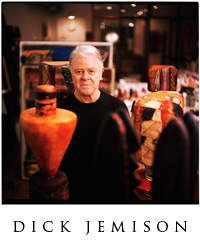Select a particular work of art to view additional information and images that can be enlarged.

Alabama native Dick Jemison grew up in Birmingham. His father, an investment banker, sent Dick to school at Choate, a college preparatory boarding school in Connecticut. On school holidays Jemison rode the train to New York City where he visited galleries and museums. On one such trip, he visited the Museum of Modern Art and was completely overwhelmed when he saw a large work by the Abstract Expressionist painter Sam Francis (1923-1994). Following this encounter, Jemison decided that he, too, wanted to "make it" in the art world.
Jemison went on to college at the University of North Carolina and then to art school, eventually earning his master's degree from the University of Georgia. He first credits his interest in art and his artistic eye to his mother, an avid art collector, then to his travels and exposure through galleries and museums to a wide array of artists.
One artist who profoundly influenced his style was Ida Kohlmeyer (1912-1997). Jemison's mother had bought an early work of Kohlmeyer's in the 1960s and, for a time in the '70s and '80s, Jemison represented her in his Birmingham gallery.
Jemison moved to Santa Fe, N.M., in the 1970s and back to Birmingham in the late 90s, where he currently has a gallery and studio where he works in both sculpture and painting. He is represented in many corporate, private, and museum collections.
Jemison works from his gut, letting intuition guide his choice of marks and colors. He immerses himself in art that stimulates his primal, elemental self, and the work he produces is the product of his visits with imagery created by others who work from similar impulses. Through the artistic filter of those influences, Jemison brings such "visits" to the canvas to share with others. Through his own hieroglyphic marks he then takes his audience along on a virtual visit with him.
Jemison's work defies categorization. It is abstract, nonrepresentational, expressionistic, sometimes referred to as "contemporary primitive." He uses the basic marks that are common to all cultures, native or not: the dot, the line, the square, the triangle, and the circle. From those elements, he makes his own personal marks with their own variations of color, mixed with his own distinctive style and imagery.
